Hybrid Hydrological Forecasting Through a Physical Model and a Weather-Informed Transformer Model: A Case Study in Greek Watershed
Abstract
1. Introduction
2. Related Work
2.1. Catchment Modelling Process
2.2. Deep Learning in Hydrology
| Study (Author and Year) | Methodology | Forecast Horizon and Data | Performance Metrics | Gap Addressed by This Study |
|---|---|---|---|---|
| Dehghani et al. (2023) [21] | LSTM, CNN, ConvLSTM | 1–6 h ahead streamflow | NSE up to 0.995 | No attention; no hybrid integration |
| Lin et al. (2021) [23] | DIFF-FFNN-LSTM hybrid | 1 h ahead (lagged flows and rainfall) | NSE = 0.99; RMSE = 9.31 m3/s | Single horizon; no attention |
| Burrichter et al. (2024) [26] | Temporal Fusion Transformer | 60 min ahead sewer overflow | VE = 36.9 L; PE = 77.4 L/s | Urban focus; no physical model integration |
| Koya and Roy (2024) [27] | Temporal Fusion Transformer | 1 day ahead across multiple basins | KGE = 0.704 | Daily only; no physical model integration |
| Neisary et al. (2025) [28] | XGBoost-based PP-ML framework | Daily NWM v2.1 flows | Median KGE = 0.69; PBias = 6.21 | No multi-horizon forecasting |
| Liu et al. (2022) [29] | VMD-CNN and SVR post-processing | Daily WRF-Hydro streamflow | CNN: NSE = 0.72; CC = 0.87; RMSE = 34.8 m3/s | Post-processing only; no multi-horizon forecasting |
| This study | Hybrid: HEC-HMS + TFT | 24, 48, 72 h | NSE = 0.84–0.71; KGE = 0.89–0.78 |
2.3. Hybrid Approaches and Post-Processing
- Hybrid methods usually outperform either model alone, often yielding improved accuracy in catchments where purely physical or purely ML approaches fall short.
- Incorporating physical knowledge tends to make ML models more robust in data-scarce and non-stationary contexts, providing an important benefit for ungauged basins and changing climates.
- From an operational perspective, hybrid models are pragmatic and feasible. Agencies can integrate ML modules into existing forecasting workflows with minimal disruption [19].
3. Materials and Methods
3.1. Study Area and Data
3.1.1. Location, Hydrology, and Climate
3.1.2. Meteorological Data
3.1.3. Hydrological Data
3.2. Framework Overview
3.2.1. Physical Model
3.2.2. Bias Correction Model
3.2.3. Deep Learning Model
4. Results and Discussion
4.1. Performance of the Bias Correction Model
4.2. Deep Learning Model Forecasting Performance
4.3. Operational and Generalization Potential
4.4. Limitations and Future Directions
5. Conclusions
Author Contributions
Funding
Institutional Review Board Statement
Informed Consent Statement
Data Availability Statement
Acknowledgments
Conflicts of Interest
References
- de Oliveira, C.M. Sustainable access to safe drinking water: Fundamental human right in the international and national scene. Rev. Ambiente Água 2017, 12, 985–1000. [Google Scholar] [CrossRef]
- UNGA Resolution. Resolution A/RES/64/292: The Human Right to Water and Sanitation; United Nations: New York, NY, USA, 2010. [Google Scholar]
- Guo, Y.; Li, P.; He, X.; Wang, L. Groundwater Quality in and Around a Landfill in Northwest China: Characteristic Pollutant Identification, Health Risk Assessment, and Controlling Factor Analysis. Expo. Health 2022, 14, 885–901. [Google Scholar] [CrossRef]
- Khan, M.H.; Nafees, M.; Muhammad, N.; Ullah, U.; Hussain, R.; Bilal, M. Assessment of Drinking Water Sources for Water Quality, Human Health Risks, and Pollution Sources: A Case Study of the District Bajaur, Pakistan. Arch. Environ. Contam. Toxicol. 2021, 80, 41–54. [Google Scholar] [CrossRef] [PubMed]
- Huang, F.; Wang, G.H.; Yang, Y.Y.; Wang, C.B. Overexploitation status of groundwater and induced geological hazards in China. Nat. Hazards 2014, 73, 727–741. [Google Scholar] [CrossRef]
- Wu, J.; Li, P.; Qian, H.; Fang, Y. Assessment of soil salinization based on a low-cost method and its influencing factors in a semi-arid agricultural area, northwest China. Environ. Earth Sci. 2014, 71, 3465–3475. [Google Scholar] [CrossRef]
- van Emmerik, T.; Mulder, G.; Eilander, D.; Piet, M.; Savenije, H. Predicting the ungauged basin: Model validation and realism assessment. Front. Earth Sci. 2015, 3, 62. [Google Scholar] [CrossRef]
- Ragkos, A.; Ambas, V. Examining the potential of an irrigation work to improve sustainability in a rural area. Water Supply 2021, 21, 2959–2973. [Google Scholar] [CrossRef]
- Coulibaly, S.; Kamsu-Foguem, B.; Kamissoko, D.; Traore, D. Deep learning for precision agriculture: A bibliometric analysis. Intell. Syst. Appl. 2022, 16, 200102. [Google Scholar] [CrossRef]
- Jain, S.K.; Mani, P.; Prakash, P.; Singh, V.P.; Tullos, D.; Kumar, S.; Agarwal, S.P.; Dimri, A.P. A Brief review of flood forecasting techniques and their applications. Int. J. River Basin Manag. 2018, 16, 329–344. [Google Scholar] [CrossRef]
- Beven, K. Data for Rainfall–Runoff Modelling. In Rainfall-Runoff Modelling; John Wiley & Sons, Ltd.: Hoboken, NJ, USA, 2012; pp. 51–82. [Google Scholar] [CrossRef]
- Rolnick, D.; Donti, P.L.; Kaack, L.H.; Kochanski, K.; Lacoste, A.; Sankaran, K.; Ross, A.S.; Milojevic-Dupont, N.; Jaques, N.; Waldman-Brown, A.; et al. Tackling Climate Change with Machine Learning. ACM Comput. Surv. 2022, 55, 1–96. [Google Scholar] [CrossRef]
- Karyotis, K.; Tziolas, N.; Tsakiridis, N.; Chatzimisios, P.; Kontoes, C.; Zalidis, G. A Multi-layered Convolutional Neural Network for Soil Variables Estimation with the Combination of Open Access Data. In Selected Studies in Geotechnics, Geo-informatics and Remote Sensing; Ergüler, Z.A., Hadji, R., Chaminé, H.I., Rodrigo-Comino, J., Kallel, A., Merkel, B., Eshagh, M., Chenchouni, H., Grab, S., Karakus, M., et al., Eds.; Springer Nature: Cham, Switzerland, 2023; pp. 129–135. [Google Scholar] [CrossRef]
- Tsakiridis, N.L.; Chadoulos, C.G.; Theocharis, J.B.; Ben-Dor, E.; Zalidis, G.C. A three-level Multiple-Kernel Learning approach for soil spectral analysis. Neurocomputing 2020, 389, 27–41. [Google Scholar] [CrossRef]
- Kalopesa, E.; Karyotis, K.; Tziolas, N.; Tsakiridis, N.; Samarinas, N.; Zalidis, G. Estimation of Sugar Content in Wine Grapes via In Situ VNIR–SWIR Point Spectroscopy Using Explainable Artificial Intelligence Techniques. Sensors 2023, 23, 1065. [Google Scholar] [CrossRef] [PubMed]
- Karyotis, K.-V.; Gülbahar, N.; Panagopoulos, A. A Two-Dimensional Nitrogen Fertilization Model for Irrigated Crops in Turkey. Am. Sci. Res. J. Eng. Technol. Sci. 2018, 41, 319–332. [Google Scholar]
- Arsenault, R.; Martel, J.-L.; Brunet, F.; Brissette, F.; Mai, J. Continuous streamflow prediction in ungauged basins: Long short-term memory neural networks clearly outperform traditional hydrological models. Hydrol. Earth Syst. Sci. 2023, 27, 139–157. [Google Scholar] [CrossRef]
- Hestness, J.; Narang, S.; Ardalani, N.; Diamos, G.; Jun, H.; Kianinejad, H.; Patwary, M.A.; Yang, Y.; Zhou, Y. Deep Learning Scaling is Predictable, Empirically. arXiv 2017, arXiv:1712.00409. [Google Scholar] [CrossRef]
- Kratzert, F.; Klotz, D.; Brenner, C.; Schulz, K.; Herrnegger, M. Rainfall–runoff modelling using Long Short-Term Memory (LSTM) networks. Hydrol. Earth Syst. Sci. 2018, 22, 6005–6022. [Google Scholar] [CrossRef]
- Nearing, G.S.; Kratzert, F.; Sampson, A.K.; Pelissier, C.S.; Klotz, D.; Frame, J.M.; Prieto, C.; Gupta, H.V. What Role Does Hydrological Science Play in the Age of Machine Learning? Water Resour. Res. 2021, 57, e2020WR028091. [Google Scholar] [CrossRef]
- Dehghani, A.; Moazam, H.M.Z.H.; Mortazavizadeh, F.; Ranjbar, V.; Mirzaei, M.; Mortezavi, S.; Ng, J.L.; Dehghani, A. Comparative evaluation of LSTM, CNN, and ConvLSTM for hourly short-term streamflow forecasting using deep learning approaches. Ecol. Inform. 2023, 75, 102119. [Google Scholar] [CrossRef]
- Ostadkalayeh, F.B.; Moradi, S.; Asadi, A.; Nia, A.M.; Taheri, S. Performance Improvement of LSTM-based Deep Learning Model for Streamflow Forecasting Using Kalman Filtering. Water Resour. Manag. 2023, 37, 3111–3127. [Google Scholar] [CrossRef]
- Lin, Y.; Wang, D.; Wang, G.; Qiu, J.; Long, K.; Du, Y.; Xie, H.; Wei, Z.; Shangguan, W.; Dai, Y. A hybrid deep learning algorithm and its application to streamflow prediction. J. Hydrol. 2021, 601, 126636. [Google Scholar] [CrossRef]
- Wegayehu, E.B.; Muluneh, F.B. Short-Term Daily Univariate Streamflow Forecasting Using Deep Learning Models. Adv. Meteorol. 2022, 2022, 1860460. [Google Scholar] [CrossRef]
- Farfán-Durán, J.F.; Cea, L. Streamflow forecasting with deep learning models: A side-by-side comparison in Northwest Spain. Earth Sci. Inform. 2024, 17, 5289–5315. [Google Scholar] [CrossRef]
- Burrichter, B.; da Silva, J.K.; Niemann, A.; Quirmbach, M. A Temporal Fusion Transformer Model to Forecast Overflow from Sewer Manholes during Pluvial Flash Flood Events. Hydrology 2024, 11, 41. [Google Scholar] [CrossRef]
- Koya, S.R.; Roy, T. Temporal Fusion Transformers for streamflow Prediction: Value of combining attention with recurrence. J. Hydrol. 2024, 637, 131301. [Google Scholar] [CrossRef]
- Neisary, S.N.; Johnson, R.C.; Alam, S.; Burian, S.J. A Post-Processing Machine Learning Framework for Bias-Correcting National Water Model Outputs by Accounting for Dominant Streamflow Drivers. Environ. Model. Softw. 2025, 190, 106459. [Google Scholar] [CrossRef]
- Liu, S.; Wang, J.; Wang, H.; Wu, Y. Post-processing of hydrological model simulations using the convolutional neural network and support vector regression. Hydrol. Res. 2022, 53, 605–621. [Google Scholar] [CrossRef]
- Lim, B.; Arık, S.Ö.; Loeff, N.; Pfister, T. Temporal Fusion Transformers for interpretable multi-horizon time series forecasting. Int. J. Forecast. 2021, 37, 1748–1764. [Google Scholar] [CrossRef]
- Zhou, R.; Wang, Q.; Jin, A.; Shi, W.; Liu, S. Interpretable multi-step hybrid deep learning model for karst spring discharge prediction: Integrating temporal fusion transformers with ensemble empirical mode decomposition. J. Hydrol. 2024, 645, 132235. [Google Scholar] [CrossRef]
- Francisco, R.; Matos, J.P.; Marinheiro, R.; Lopes, N.; Portela, M.M.; Barros, P. Application of Temporal Fusion Transformers to Run-Of-The-River Hydropower Scheduling. Hydrology 2025, 12, 81. [Google Scholar] [CrossRef]
- Huang, F.; Ochoa, C.G.; Li, Q.; Shen, X.; Qian, Z.; Han, S.; Zhang, N.; Yu, M. Forecasting environmental water availability of lakes using temporal fusion transformer: Case studies of China’s two largest freshwater lakes. Environ. Monit. Assess. 2024, 196, 152. [Google Scholar] [CrossRef]
- Ampas, T.; Refanidis, I. Leveraging deep learning methods to enhance hydrological predictions and model interpretability. In SETN ’24, Proceedings of the 13th Hellenic Conference on Artificial Intelligence, Piraeus, Greece, 11–13 September 2024; Association for Computing Machinery: New York, NY, USA, 2024; pp. 1–6. [Google Scholar] [CrossRef]
- Kumar, S.; Choudhary, M.K.; Thomas, T. A hybrid technique to enhance the rainfall-runoff prediction of physical and data-driven model: A case study of Upper Narmada River Sub-basin, India. Sci. Rep. 2024, 14, 26263. [Google Scholar] [CrossRef] [PubMed]
- Difi, S.; Heddam, S.; Zerouali, B.; Kim, S.; Elmeddahi, Y.; Bailek, N.; Santos, C.A.G.; Abida, H. Improved daily streamflow forecasting for semi-arid environments using hybrid machine learning and multi-scale analysis techniques. J. Hydroinform. 2024, 26, 3266–3286. [Google Scholar] [CrossRef]
- Samarinas, N.; Tziolas, N.; Zalidis, G. Improved Estimations of Nitrate and Sediment Concentrations Based on SWAT Simulations and Annual Updated Land Cover Products from a Deep Learning Classification Algorithm. ISPRS Int. J. Geo-Information 2020, 9, 576. [Google Scholar] [CrossRef]
- Lin, Y.; Wang, D.; Meng, Y.; Sun, W.; Qiu, J.; Shangguan, W.; Cai, J.; Kim, Y.; Dai, Y. Bias learning improves data driven models for streamflow prediction. J. Hydrol. Reg. Stud. 2023, 50, 101557. [Google Scholar] [CrossRef]
- Choi, J.; Kim, S. Data-driven model as a post-process for daily streamflow prediction in ungauged basins. Heliyon 2025, 11, e42512. [Google Scholar] [CrossRef]
- Woldemeskel, F.; McInerney, D.; Lerat, J.; Thyer, M.; Kavetski, D.; Shin, D.; Tuteja, N.; Kuczera, G. Evaluating post-processing approaches for monthly and seasonal streamflow forecasts. Hydrol. Earth Syst. Sci. 2018, 22, 6257–6278. [Google Scholar] [CrossRef]
- Ambas, V.; Baltas, E. Spectral Analysis of Hourly Solar Radiation. Environ. Process. 2014, 1, 251–263. [Google Scholar] [CrossRef][Green Version]
- Ampas, V. Research and Estimation of Meteorological Parameters with Direct Impact on Agriculture. Ph.D. Thesis, Aristotle University of Thessaloniki, Thessaloniki, Greece, 2010. [Google Scholar]
- Allen, R.G. (Ed.) Crop Evapotranspiration: Guidelines for Computing Crop Water Requirements; Repr. in FAO Irrigation and Drainage Paper, No. 56; Food and Agriculture Organization of the United Nations: Rome, Italy, 2000. [Google Scholar]
- Lehner, B.; Verdin, K.; Jarvis, A. New Global Hydrography Derived From Spaceborne Elevation Data. Eos Trans. Am. Geophys. Union 2008, 89, 93–94. [Google Scholar] [CrossRef]
- European Union’s Copernicus Land Monitoring Service Information; European Commission: Brussels, Belgium, 2019; EU-Hydro River Network Database 2006–2012 (vector). [CrossRef]
- Mishra, S.K.; Singh, V.P. SCS-CN Method. In Soil Conservation Service Curve Number (SCS-CN) Methodology; Mishra, S.K., Singh, V.P., Eds.; Springer: Dordrecht, The Netherlands, 2003; pp. 84–146. [Google Scholar] [CrossRef]
- Clark, C.O. Storage and the Unit Hydrograph. Trans. Am. Soc. Civ. Eng. 1945, 110, 1419–1446. [Google Scholar] [CrossRef]
- Chow, V.T.; Maidment, D.R.; Mays, L.W. Applied Hydrology; McGraw-Hill Series in Water Resources and Environmental Engineering; McGraw-Hill: New York, NY, USA, 1988. [Google Scholar]
- Nash, J.E.; Sutcliffe, J.V. River flow forecasting through conceptual models part I—A discussion of principles. J. Hydrol. 1970, 10, 282–290. [Google Scholar] [CrossRef]
- Kling, H.; Fuchs, M.; Paulin, M. Runoff conditions in the upper Danube basin under an ensemble of climate change scenarios. J. Hydrol. 2012, 424–425, 264–277. [Google Scholar] [CrossRef]
- Clevert, D.-A.; Unterthiner, T.; Hochreiter, S. Fast and Accurate Deep Network Learning by Exponential Linear Units (ELUs). arXiv 2016, arXiv:1511.07289. [Google Scholar] [CrossRef]
- Dauphin, Y.N.; Fan, A.; Auli, M.; Grangier, D. Language Modeling with Gated Convolutional Networks. arXiv 2017, arXiv:1612.08083. [Google Scholar] [CrossRef]
- Akiba, T.; Sano, S.; Yanase, T.; Ohta, T.; Koyama, M. Optuna: A Next-generation Hyperparameter Optimization Framework. arXiv 2019, arXiv:1907.10902. [Google Scholar] [CrossRef]
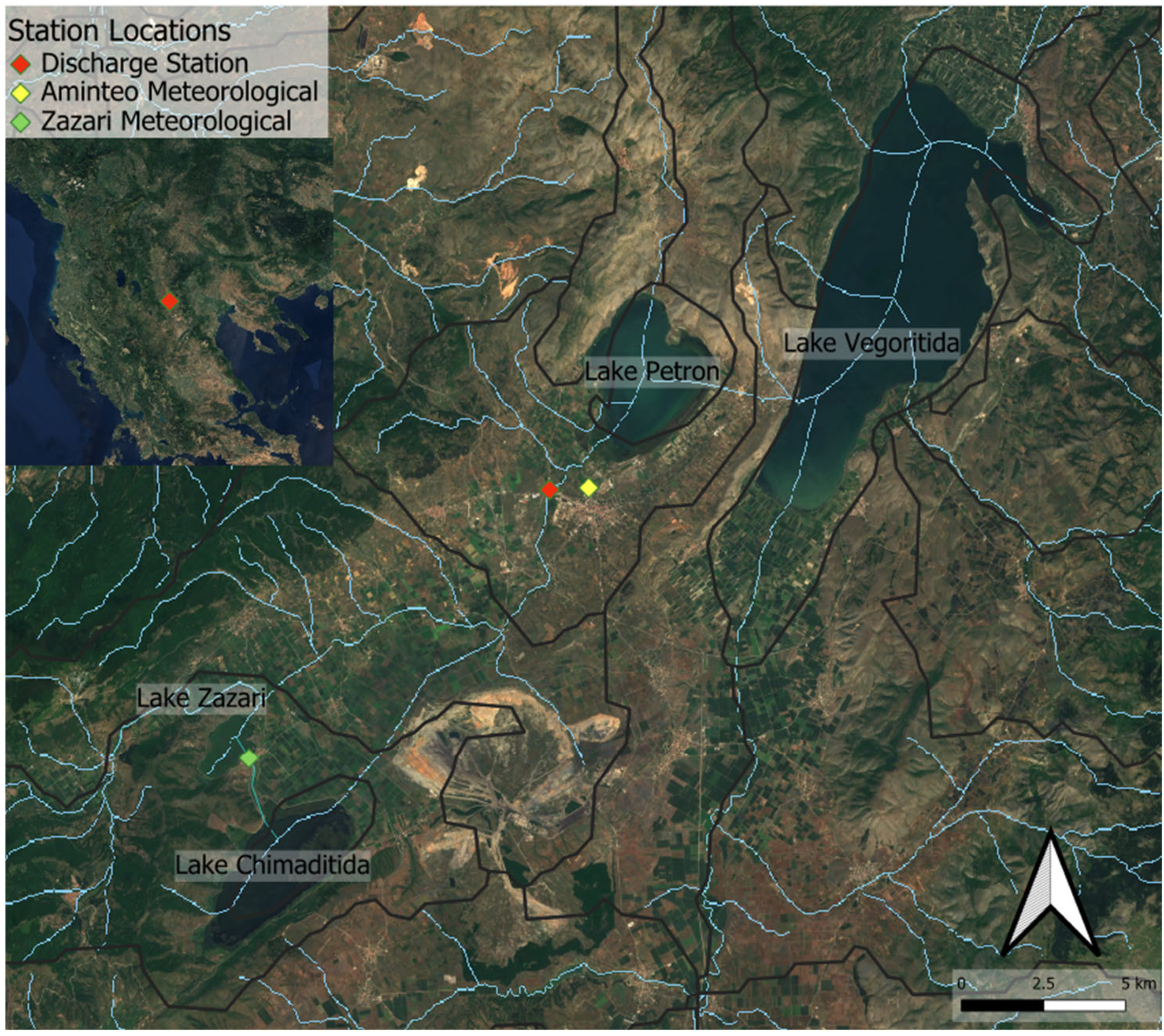
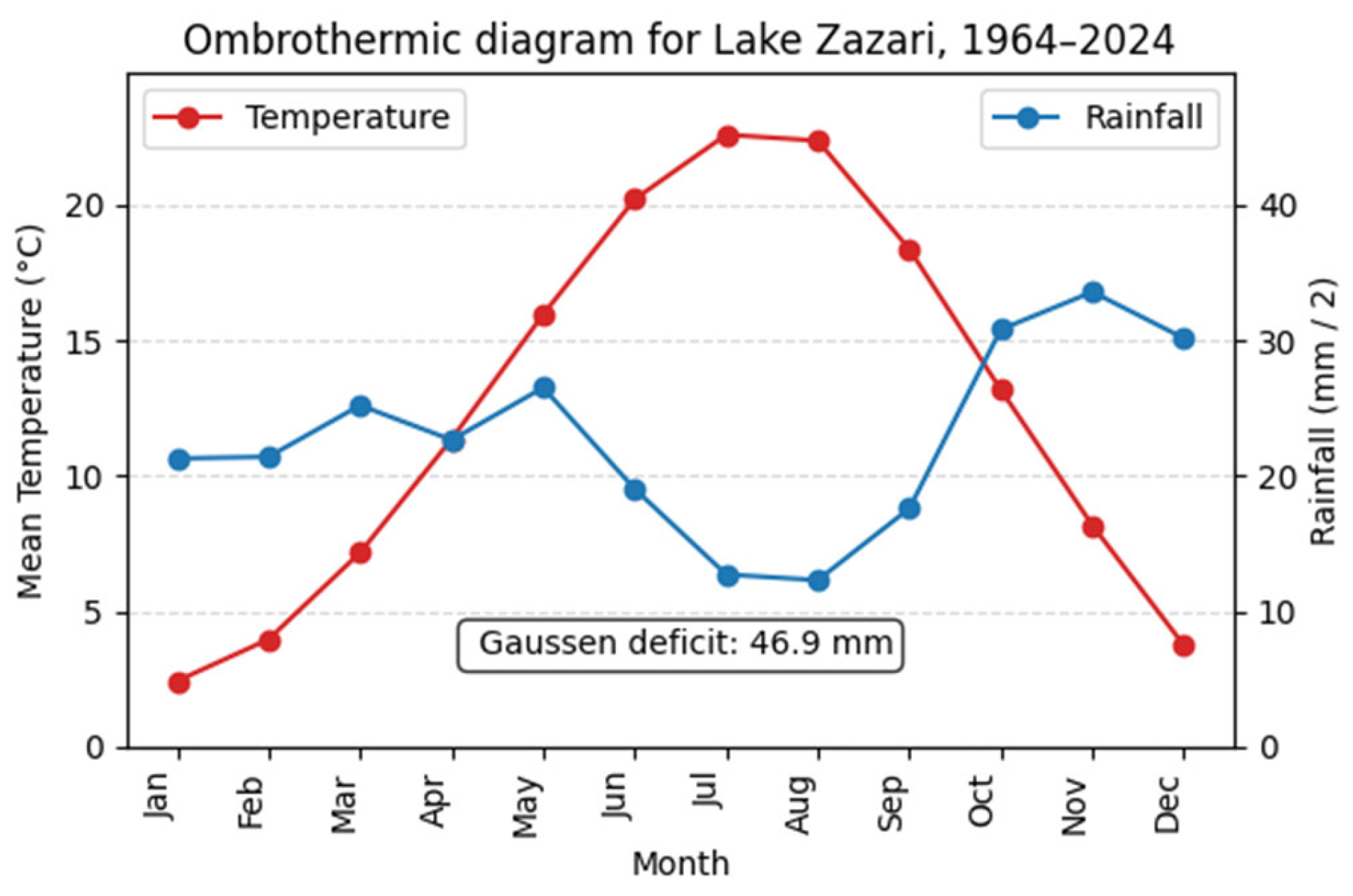

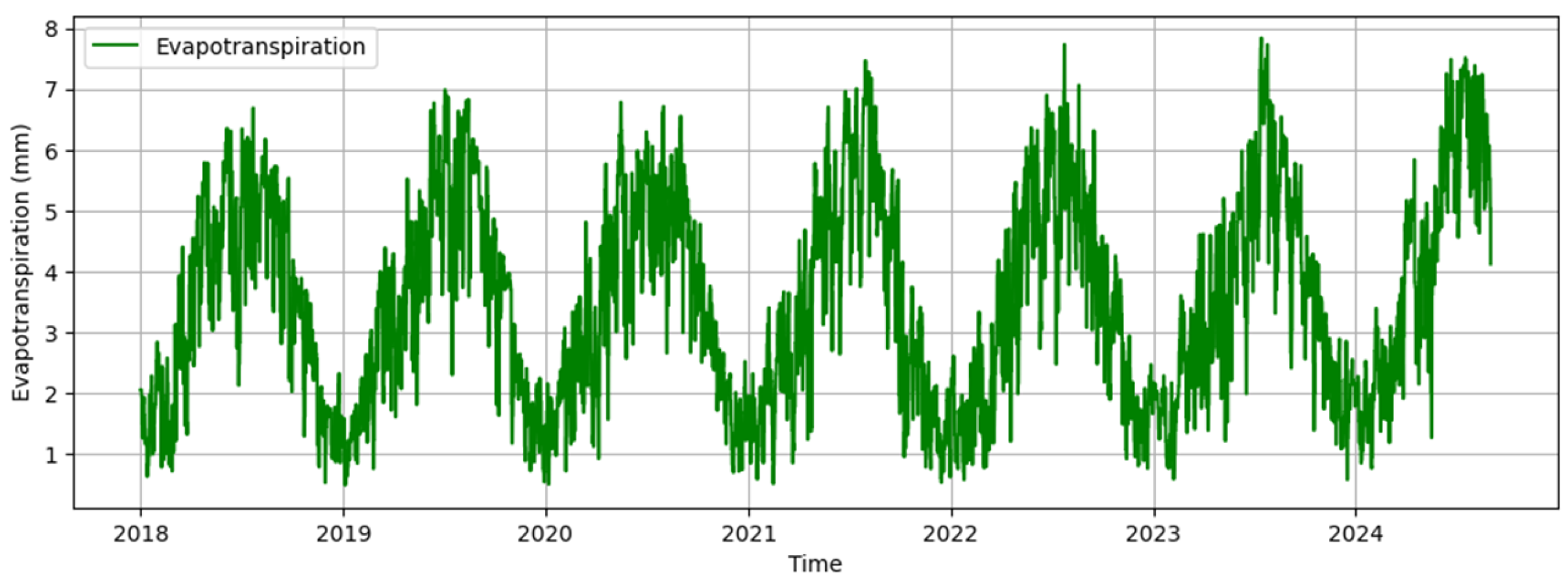

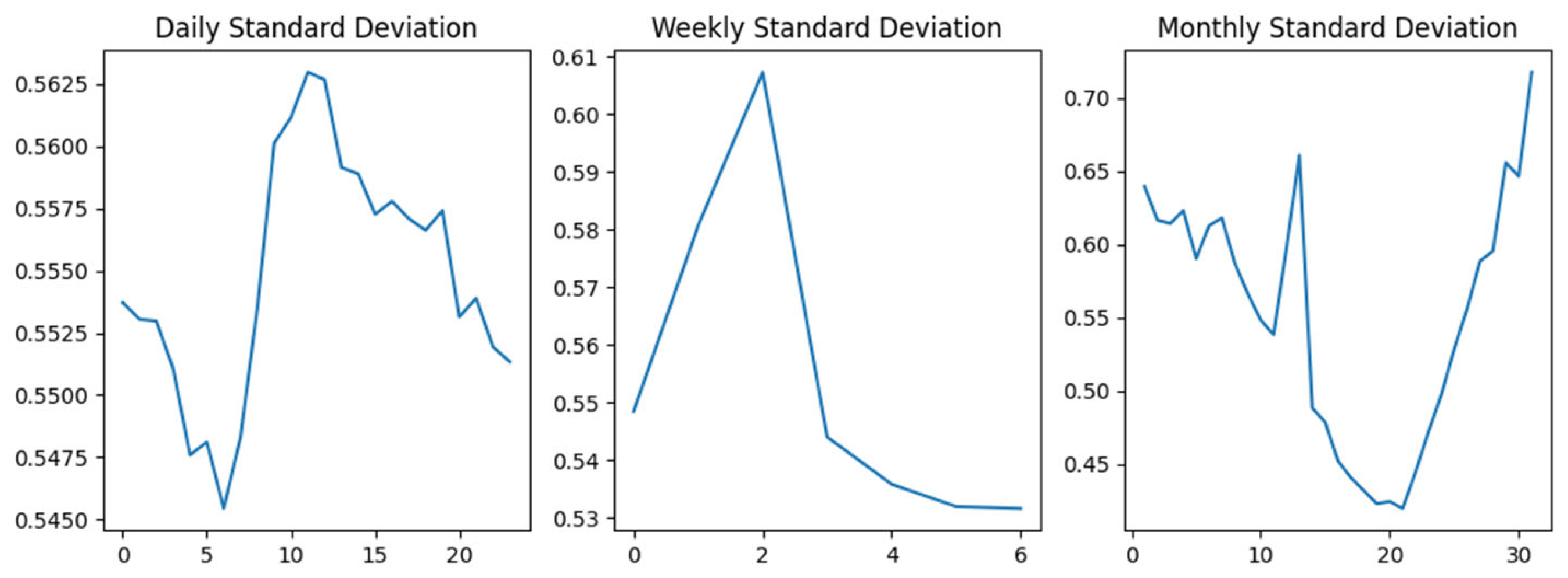

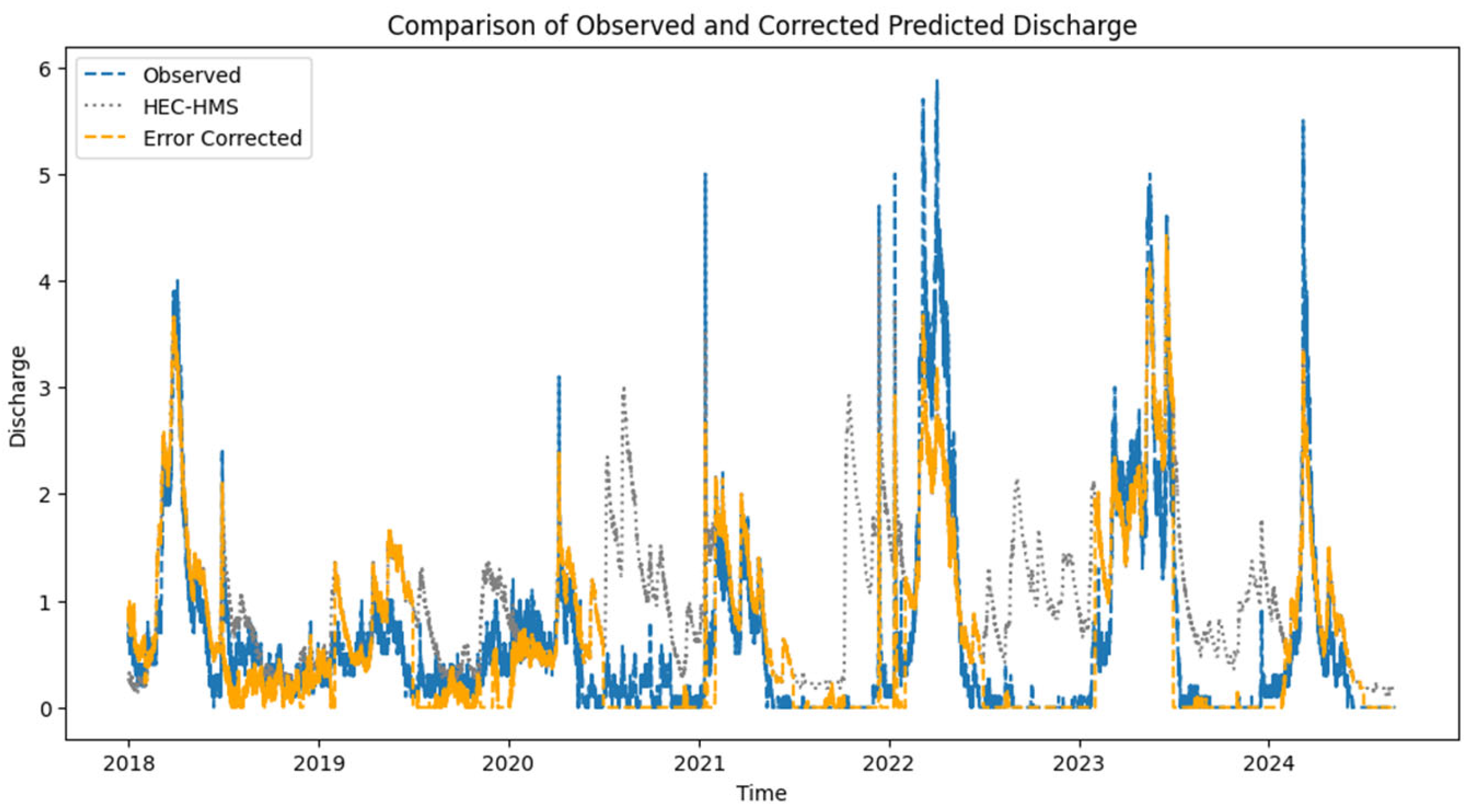

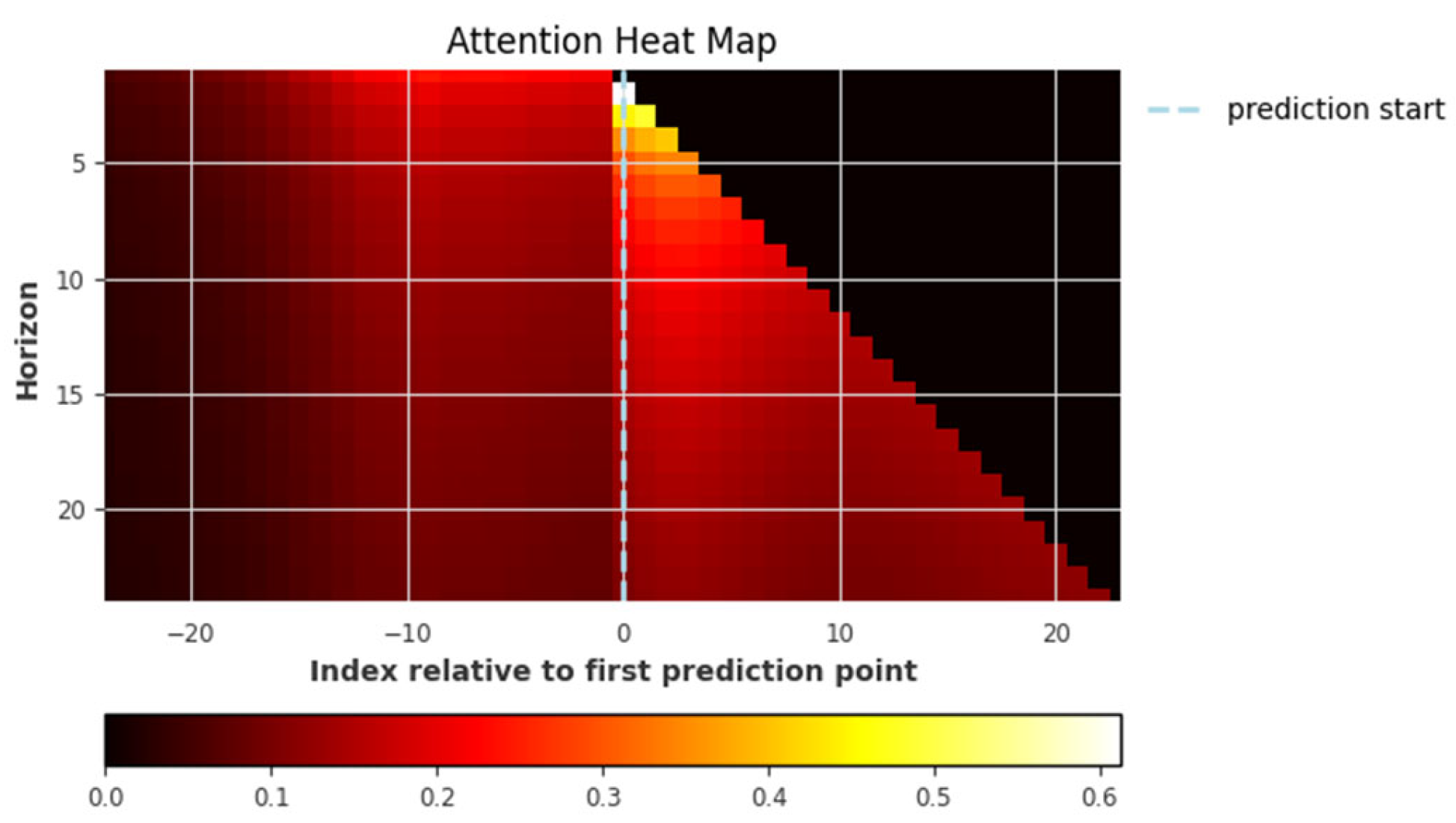
| Model Input Type | NSE | KGE | RMSE |
|---|---|---|---|
| Raw Synthetic Discharge (uncorrected) | 0.55 | 0.67 | 1.084 |
| Bias-corrected Synthetic Discharge | 0.84 | 0.89 | 0.301 |
| Observed Discharge (ideal case) | 0.90 | 0.92 | 0.247 |
| Forecast Horizon | NSE | KGE | RMSE |
|---|---|---|---|
| 24 h ahead | 0.84 | 0.89 | 0.301 |
| 48 h ahead | 0.78 | 0.79 | 0.743 |
| 72 h ahead | 0.71 | 0.74 | 0.980 |
| Model Input Type | Mean CRPS | 60% cov. | 80% cov. | 98% cov. |
|---|---|---|---|---|
| Raw Synthetic Discharge (uncorrected) | 0.615 | 0.522 | 0.712 | 0.894 |
| Bias-corrected Synthetic Discharge | 0.174 | 0.634 | 0.791 | 0.966 |
| Observed Discharge (ideal case) | 0.151 | 0.621 | 0.806 | 0.974 |
Disclaimer/Publisher’s Note: The statements, opinions and data contained in all publications are solely those of the individual author(s) and contributor(s) and not of MDPI and/or the editor(s). MDPI and/or the editor(s) disclaim responsibility for any injury to people or property resulting from any ideas, methods, instructions or products referred to in the content. |
© 2025 by the authors. Licensee MDPI, Basel, Switzerland. This article is an open access article distributed under the terms and conditions of the Creative Commons Attribution (CC BY) license (https://creativecommons.org/licenses/by/4.0/).
Share and Cite
Ampas, H.; Refanidis, I.; Ampas, V. Hybrid Hydrological Forecasting Through a Physical Model and a Weather-Informed Transformer Model: A Case Study in Greek Watershed. Appl. Sci. 2025, 15, 6679. https://doi.org/10.3390/app15126679
Ampas H, Refanidis I, Ampas V. Hybrid Hydrological Forecasting Through a Physical Model and a Weather-Informed Transformer Model: A Case Study in Greek Watershed. Applied Sciences. 2025; 15(12):6679. https://doi.org/10.3390/app15126679
Chicago/Turabian StyleAmpas, Haris, Ioannis Refanidis, and Vasilios Ampas. 2025. "Hybrid Hydrological Forecasting Through a Physical Model and a Weather-Informed Transformer Model: A Case Study in Greek Watershed" Applied Sciences 15, no. 12: 6679. https://doi.org/10.3390/app15126679
APA StyleAmpas, H., Refanidis, I., & Ampas, V. (2025). Hybrid Hydrological Forecasting Through a Physical Model and a Weather-Informed Transformer Model: A Case Study in Greek Watershed. Applied Sciences, 15(12), 6679. https://doi.org/10.3390/app15126679






